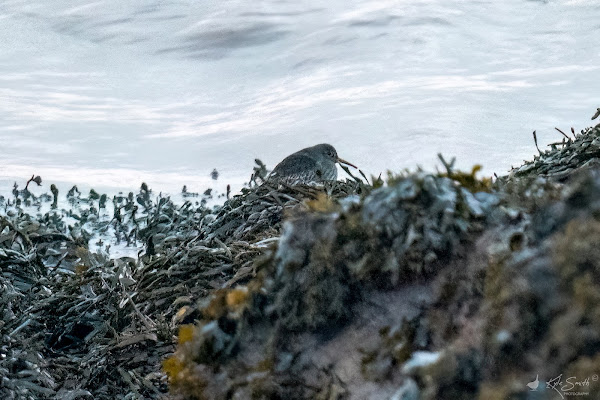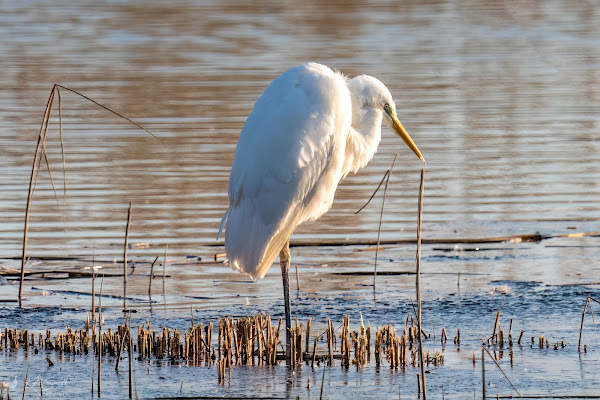I picked Kevin Heath (@kev07713) up at 5.45am and set out through the ice, cold and fog - the car was reading -4°C as we got into the countryside and the fog gradually worsened through Chipping Norton and Long Compton. Fortunately, it improved a little and made the journey a little less stressful, at least until I drove straight past our breakfast stop. What comes of focussing too hard on the road and not thinking ahead ... no major issue though and 10 minutes later we were sitting having a coffee and a roll and sausage. We left and Kev called his sister Karen (@hobbylovinglife) who we were to meet - with her partner in crime Dean (@worlebirder) - at Battery Point Lighthouse, Portishead. They were already almost there but we still had another half an hour to run, not helped by my earlier error ...
We arrived and heeded the warning of a steep slope down to the car park and the icy conditions, parking up next to Karen's car. We could see Karen and Dean out on the point and scoping the rocks - hopefully they would be on the birds we were here to see. We made our way over, said our hellos, and were told that there were at least two purple sandpipers on the rocks at the far end but mostly obscured by the seaweed. We viewed through the scopes and soon found them scurrying around - we decided there were three. It was still cold and around -2°C - I was glad I'd put my gloves in my jacket pockets. To our left we heard and then saw curlew but there wasn't much else out on the water. The tide was going out quickly after the 6.00am high tide and we discussed the plan of action - Karen and Dean were going to go and tick the local Hume's warbler at Compton Dando while we would visit Burnham-on-Sea to try and find the Kentish plover. We would then meet up at RSPB Ham Wall and see if we could add the American Wigeon along Shapwick Heath and then the lesser scaup on the RSPB reserve.
Karen and Dean were first to get away, but we would soon be on our way arriving at Burnham-on-Sea with reports that the Kentish plover was likely to be seen from much the same place as when we visited in October. It was now 9.05am and the tide was out, exposing the beaches - we joined a handful of birders on the promenade, and they relayed that a couple of them had seen our bird 20 minutes earlier but on the very far island - some of them had apparently not. The bird had left with a group of circa 8 ringed plovers and headed further away and out of sight. We scanned the beach just in front of us and picked out four ringed plovers but not our target bird. There were plenty of dunlin, shelduck and avocets plus a few grey plovers in view - despite searching for an hour and a half we weren't able to find any signs of our bird. We decided to put this down as a dip and climbed into the car to make for RSPB Ham Wall and Avalon Marsh'sShapwick Heath (opposite one another).
We arrived at RSPB Ham Wall, put on our boots and made our way out along the main path through Shapwick Heath to where the American wigeon had been showing. We arrived to find only a couple of people in place, possibly as our bird was asleep and head tucked into its wing. We watched and waited as the wigeon lifted its head for seconds at a time and hoped it would give better views. Eventually it turned, walked a couple of feet, and went back to sleep - just walking far and long enough for a couple of photos. A little later it walked back giving another few seconds of opportunity for a photo. While we waited, we watched occasional marsh harriers over the back of the pool and a pair of stonechats along the front. There were frequent calls from Cetti's warbler behind but all we could see were a small flock of long-tailed tits feeing in the scrub and hedges.
Kev had a call from his sister to say she and Dean had arrived in the car park and so we made our way back, stopping to watch a chiffchaff on the way. We met by the cars and ate our sandwich lunches while we decided on the plan of attack. A couple of Karen and Dean's friends spotted them and came across for a chat after which we set out onto the reserve - apparently there had been no sighting of the lesser scaup all morning but we would go and have a look anyway - the water would be frozen and the chances were slim. We stopped on the bridge to watch a couple of chiffchaffs feeding some distance away and then moved on to the path aiming for the Avalon Hide. We stopped to watch a goldcrest and then Karen called a lesser redpoll, then two. A number of people stopped to see what we were looking at - they were far from obvious and difficult to keep eyes on even when you knew roughly where they were.
Before we got much further, first a pair and then a third raven flew over, cronking as they went - this was then followed by close passes from a couple of marsh harriers, a male and then a female.
We walked on down to the Avalon Hide but couldn't reach it as the path was under water and impassable. We saw some stonking redwings and as we watched a couple of water rails seemed to have an altercation, not far ahead but out of view. Frequent calls kept us in place, as did the accompanying Cetti's warblers on all sides. Eventually Kev was rewarded with a view of a water rail scuttling across the ice as it traversed a narrow channel. I missed that pass but took up position in case of a return. A quarter of an hour or more passed where we watched chiffchaff feeding and walking on the ice, then a Cetti's warbler dropped into view but down into the reeds soon after. A female reed bunting dropped onto the seed tops ahead and looked so settled I had to take a photo.
In the end I was blessed with a short pass of the returning water rail which is my first of the year. There was more action as the water rails interacted again. We were going to be disappointed by the lesser scaup as the water was completely frozen over - however Karen looked on her phone and saw that it had been reported on Noah's Lake over on Shapwick Heath just 20 minutes before. We packed up and made our way - we lost Dean and then Karen as I rushed along and they stopped to talk to friends - this would be a lifer for me but not for the other three. We watched great-white egrets and buzzards sitting out on the ice as we made our way.
It was a long yomp as I dragged Kev along with me to where the pin had been dropped on Birdguides - "female at Noah's Lake mid-afternoon" was the information provided. I reached the spot and could see hundreds of ducks in silhouette, including my first pintail of the year. It wouldn't be possible to pick it out like this ... Kev caught up and I asked a birder coming the other way if he knew how the bird had been spotted - it had been him that had found it three quarters of an hour before and he confirmed it wasn't where we should be - apparently we were meant to be viewing from a hide back down the path and to the west of the lake. It would have been good to have this information in the update ...
I apologised to Kev for dragging him here and we made our way back and received a call from Karen to ask where we were - she and Dean were already there. Damn. We eventually arrived at the hide and joined the other two. Kev set up his scope and began to scan, trying to follow instructions from two birders as to where we should be looking. Karen and Dean got on the bird just before Kev but between diving and trying to pick it out I couldn't get on it through either of the scopes - frustrating for me and the people trying to share the sighting. Eventually I got there and added another lifer. Kev remarked on how much more difficult it was to see than the male at Staines in the week.
Content with our views we worked back to the car and parted with Karen and Dean as they went off to watch the starling murmuration - I had to get home as I was to go out and meet some friends in the evening. We exited the car park which was now rammed, and the road verges were also lined with cars as far as the eye could see - apparently there are up to 600,000 birds in this flock at the moment and are a very popular sight - great to think so many people are interested.
Year List: 116
















No comments:
Post a Comment